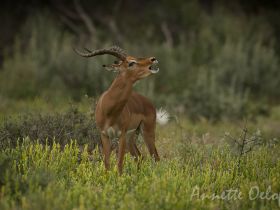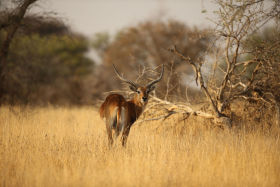An interview about the importance of the big picture, the power of nature, and the contribution that sustainable hunting can make to the protection of nature and biodiversity.
In the middle of Namibia, on an area of 35,000 hectares (86,000 acres) of land, lies the Okonjati Game Reserve. Countless species of wild animals and birds find a protected habitat there. Annette Oelofse has been running this reserve for around 35 years. For many decades she did so together with her husband, conservationist Jan Oelofse, who founded the sanctuary in the mid-1970s. Today, she is running the reserve together with her son Alexander and his family. Every day, Annette Oelofse experiences the cycle of life, the inseparable connection between human beings and nature. Everything at the Okonjati Game Reserve contributes to a greater whole, from preserving the wild game species to rearing of orphaned rhinos, from sustainably managing the hunting and ecotourism income to providing school education for the children of her staff.
And all this has one ultimate goal: to give back to nature and preserve Namibia’s incredible wildlife for generations to come.
Together with your son Alex, you are running the 35,000-hect-are (86,000-acre) Okonjati Game Sanctuary in Namibia. Please tell us about it. How was the sanctuary established?
“Give back more than what you take out” – this was the philosophy and goal of my late husband Jan Oelofse, a world-renowned conservationist, who founded the Okonjati Game Reserve in 1975. He leased approxi-mately 5,000 hectares (12,000 acres) of land, a farm with the name of “Etjo” (“Etjo,” quite fittingly, means “place of refuge”), previously used for cattle ranching. He pitched his tents under a huge Acacia tree, fixed the telephone to the tree trunk, and with only 700 Namibia Dollar in his pocket, courage, determination, and a love of nature, he worked toward his goal. I met him during the early eighties. We re-introduced many new species of game to the leased land, which we later purchased together with neighboring land. We named it “Okonjati” (“Place of the buffalo,” named after the fossilized buffalo footprints found on the property) and thus founded the Okonjati Game Reserve.
I had the privilege to live and work side by side with Jan for 30 years to build up the Okonjati Game Reserve to its size of 35,000 hectares (86,000 acres) today and create an environment for hundreds of different species of wildlife and birds.
Our son Alexander was born in 1985, the same year we introduced the elephants into the area. Alex was part of our beautiful journey. My late husband’s spirit lingers on in the animals that roam the fields, in the earth, and in the wind.

Which species of wildlife live in your sanctuary?
Our area is home to over 8,000 animals. More than 35 different wildlife species are part of the ecosystem in our wildlife sanctuary. You can observe cheetahs, elephants, white and black rhinos, hippos, lions, numerous antelopes such as the smallest Damaraland Dik-Dik, Kudu, Nyala, and Gemsbuck, two different species of zebras, warthog, and the smaller antelope such as Springbuck, Impala, Blesbuck, and many more…
Your staff make a significant contribution to the success of your sanctuary. What are the benefits you provide to your employees?
Our whole team of 80 permanent employees live in the area of the Okonjati Wildlife Reserve. We have 65 staff houses for our employees and their families. They enjoy the privilege of free water and electricity and can grow their own vegetables. All our staff is provided with meat from the hunt and starch rations and earn a good income generated by tourism and hunting. The grandparents of some of our workers have already worked for Jan and myself and the next generations are still employed by us. We provide schooling for their children and assist them via sponsors to attend high school as well as the “Amy Bell” Scholarship program to enroll at universities. Education in the bush with all its wildlife leaves long-lasting impressions on our children, the foundations are laid for their lives. This is the biggest enrichment we can offer to our future generations.


In order to generate funds for his vision – the development of the Okonjati Game Reserve and nature conservation – Jan Oelofse established lodging facilities very early on. There are now three different lodges in the reserve, two being the Mount Etjo Safari Lodge and the Elephant Lodge for hunting tourists. The hunts are organized by the team of Jan Oelofse Hunting Safaris. Guests can expect luxurious accommodation, homemade African cuisine, and incredible impressions of Namibia’s wildlife.
How does hunting contribute to game management, but also to the reserve’s finances?
Hunting plays a very important role in our game reserve. Since our area is fenced for the safety of wildlife and the environment, constant wildlife management is a priority. It is hard work, a great responsibility, and very costly. The proceeds are generated by hunting as well as ecotourism, live wildlife sales to stock new areas, breeding of rare species, and meat production. All facets are intertwined. We are constantly making ethical decisions. We have to decide which species, how many of them, how and when to either capture, sell, and move to new areas or professionally hunt. All proceeds are continuously re-invested to protect our wilderness and wildlife and to enlarge the area. Hunting in a very professional and ethical manner only harvests a minute amount of mature animals, but generates almost half of the reserve’s income.

You are incredibly active. How do you personally recharge your batteries? What gives you strength?
Stillness! Absorbing nature at a secluded place or just gliding through the calm morning air with my plane, enjoying the beauty and freedom of flight clears my mind. It puts everything in perspective and reminds me of the privilege it is to live so close to nature. Nature is my energy source. I can feel it already in the first rays of the sunrise, while I am feeding my orphaned rhino calves with the first warm milk of the day. Just listening to the sound of the orphans contentedly suckling away at the milk is so enriching. I enjoy these precious moments and deeply appreciate the privilege of living this life. This is where I tap my energy for the day. And: my energy also comes from the happiness and health of my son Alex, his wife Carola, and my two grandchildren – that is life, that is my energy.


What would you like to pass on to future generations?
“Less is more, choose it well and make it last.” Always remember that nature is life. Stay part of this beautiful ecosystem for your children to be able to walk barefoot, to feel the sand between their toes, to count the butterflies, to surf clean waves, to pick berries from the woods, to dive in a sparkling ocean, to smell clean air, and to taste the refreshing water from the planet’s springs. This said, I wish for the next generations to grasp how important the whole ecosystem is for our own survival. That we are an integral part of the chain. That only the beauty of all past generations be enshrined in the foundation of each new generation, that they learn from our mistakes, and only take the good to build on and preserve our planet and the abundance of species.
Thank you for the interview.

ABOUT
ANNETTE OELOFSE
Annette Oelofse was born in Otjiwarongo, a small town in northern Namibia. Her mother had immigrated from Germany in the 1950s. She grew up on a cattle ranch run by her parents in the middle of the bush. Since early childhood, Annette and her three brothers helped with the farm work: driving cattle, vaccinating animals, and milking the cows. They accompanied their father on hunts and later hunted themselves. “Most nights we came home sweaty and dusty. We loved it.” Life in the bush in harmony with nature and her parents’ tireless dedication and diligence made Annette Oelofse the person she is today. In the 1980s, she married Jan Oelofse, a well-known wildlife conservationist. Their son Alexander was born in 1985. For 30 years, Annette and Jan worked together to build the Okonjati Game Reserve. Today Annette runs the reserve and lodges together with her son, his wife Carola, and their two children. She loves nature in all its facets, and also enjoys camping and photography.





















